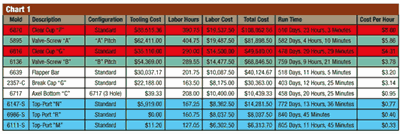To Rail or Not to Rail
One of the most interesting parts of performing a maintenance capability assessment (MCA) in mold plants around the globe is observing the different styles practiced when repair technicians work on molds. When talking to repair techs about why they like a particular method or tool it is easy to see why they would think there is only one way to do things. It’s simply how they were taught by the older, tenured repair technicians.
Every mold has specific characteristics that require repair technicians to consider when putting it through the eight stages of repair (discussed in June 2008, page 98). There are a few techniques, though, that some repair techs try to incorporate on all molds. One of these—the use of rails under molds—hits a special nerve with me.
What Are They?
Rails, or some call them parallels, are nothing more than different types of blocks used to elevate a mold up off the bench top. They are made from a variety of materials in a variety of sizes, lengths and designs. Most are simply 3, 4, or 5-inch square tube stock the length of a mold bench. Some have hardened bar stock, like O-1 bolted to the tops of the tube stock. Others are more elaborate with holes drilled in them for round bars to be placed to hold up plates while others are simply welded right to the tops of the benches.
In my old shop, all of our 14 mold repair technicians made use of rails to set and work on molds. The reasoning behind this was that some molds have water lines and other components sticking out of the bottom that makes it impossible for a mold to sit flat on the bench. Rail height was determined by the length of the stuff hanging off the bottom of the mold.
Types of Rails
One day I was assigned a mold that was 3 feet tall x about 24 inches deep and about 4,000 pounds. The bottom of the mold was perfectly flat with no components or water lines hanging out. Since my “personal” sets of rails were in use on another mold, I decided to do without that day.
I picked the mold up and gave the bottom a quick pass with my file and a medium stone just to make sure there were no burs, set it back down and proceeded to disassemble it. Gosh—what a discovery. I found the mold plates, although tall and heavy, slid along my bench top quite easily—not nearly as hard as I was told it would be. As I proceeded through the clean and repair of the tool I discovered even more nice things about working directly off the bench top versus rails.
- Tools, tooling nuts and bolts could no longer roll under mold plates and hide from my view.
- Mold plates could be turned to face me or move them around without the fear of the supporting “feet” slipping off the rails and tumbling over.
- It was much more comfortable and safe (no bending over to get in between standing plates) to work on the mold.
- Bores and other internal areas could be inspected easier and better without fear of the “domino” effect.
- Easier to do simple tasks and with more control like numbering plates, tooling or removing broken dowel pins and chamfering water lines.
- Easier to keep my bench top clean and free of the bits of plastic, dirt and grime that normally falls into the dead zone between the rails—that never gets cleaned.
It was so nice being able to work comfortably and with more control that from that day on I would even take a few minutes to remove water fittings and other components allowing most of our molds to sit flat on the bench. The 15 minutes or so to do this was well worth the time and before long—no one in our shop used rails unless it was absolutely necessary—on about 10 percent of our molds. Try it—I think you’ll like it.
Related Content
MMT Chats: The Science of Moldmaking, Part 2
In Part 2 of this two-part MMT Chat, Christina and Don continue their conversation by exploring lean manufacturing and tips on how to attract, train and retain the future workforce.
Read MoreHands-on Workshop Teaches Mold Maintenance Process
Intensive workshop teaches the process of mold maintenance to help put an end to the firefighting culture of many toolrooms.
Read MoreMaking Quick and Easy Kaizen Work for Your Shop
Within each person is unlimited creative potential to improve shop operations.
Read MoreHow to Foster Innovation Through a Culture of Education, Mentoring
Dynamic Tool Corp. shares its strategy for building a team with the right attitude and aptitude to deliver innovation that meets customer expectations.
Read MoreRead Next
Building a Better Mold
A look at mold performance and maintenance issues through a few simple reports in the right sequence will allow you to drill down into what the issues are really costing you.
Read MoreHow to Use Strategic Planning Tools, Data to Manage the Human Side of Business
Q&A with Marion Wells, MMT EAB member and founder of Human Asset Management.
Read MoreHow to Use Continuing Education to Remain Competitive in Moldmaking
Continued training helps moldmakers make tooling decisions and properly use the latest cutting tool to efficiently machine high-quality molds.
Read More





















